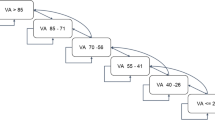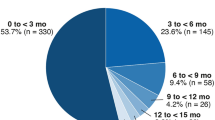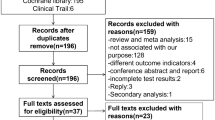Abstract
Aflibercept (Eylea®) is an anti-vascular endothelial growth factor agent indicated for intravitreal use in the treatment of diabetic macular oedema. In patients with diabetic macular oedema, significantly greater improvements from baseline to week 52 in visual acuity were seen with intravitreal aflibercept versus macular laser photocoagulation in the phase III VISTA-DME and VIVID-DME trials, and versus intravitreal bevacizumab or ranibizumab in those with worse visual acuity at baseline (i.e. Early Treatment Diabetic Retinopathy Study letter score of <69) in the phase III PROTOCOL-T trial. Intravitreal aflibercept was generally well tolerated in patients with diabetic macular oedema. In conclusion, intravitreal aflibercept is an important new treatment for diabetic macular oedema.

Similar content being viewed by others
References
Aiello LP. Angiogenic pathways in diabetic retinopathy. N Engl J Med. 2005;353(8):839–41.
Klein BEK. Overview of epidemiologic studies of diabetic retinopathy. Ophthalmic Epidemiol. 2007;14(4):179–83.
Singh A, Stewart JM. Pathophysiology of diabetic macular edema. Int Ophthalmol Clin. 2009;49(2):1–11.
Virgili G, Parravano M, Menchini F, et al. Anti-vascular endothelial growth factor for diabetic macular oedema. Cochrane Database Syst Rev. 2014;10:CD007419.
Stewart MW. The expanding role of vascular endothelial growth factor inhibitors in ophthalmology. Mayo Clin Proc. 2012;87(1):77–88.
Simó R, Sundstrom JM, Antonetti DA. Ocular anti-VEGF therapy for diabetic retinopathy: the role of VEGF in the pathogenesis of diabetic retinopathy. Diabetes Care. 2014;37(4):893–9.
Carmeliet P, Moons L, Luttun A, et al. Synergism between vascular endothelial growth factor and placental growth factor contributes to angiogenesis and plasma extravasation in pathological conditions. Nat Med. 2001;7(5):575–83.
European Medicines Agency. Eylea (aflibercept): EU summary of product characteristics. 2015. http://www.ema.europa.eu/. Accessed 1 May 2015.
Regeneron Pharmaceuticals Inc. EYLEA® (aflibercept): US prescribing information. 2015. http://www.eylea.us/. Accessed 1 May 2015.
Frampton JE. Aflibercept for intravitreal injection: in neovascular age-related macular degeneration. Drugs Aging. 2012;29(10):839–46.
Yang LPH, McKeage K. Intravitreal aflibercept (Eylea®): a review of its use in patients with macular oedema secondary to central retinal vein occlusion. Drugs Aging. 2014;31(5):395–404.
Holash J, Davis S, Papadopoulos N, et al. VEGF-trap: a VEGF blocker with potent antitumor effects. Proc Natl Acad Sci USA. 2002;99(17):11393–8.
Papadopoulos N, Martin J, Ruan Q, et al. Binding and neutralization of vascular endothelial growth factor (VEGF) and related ligands by VEGF Trap, ranibizumab and bevacizumab. Angiogenesis. 2012;15(2):171–85.
Stewart MW, Rosenfeld PJ. Predicted biological activity of intravitreal VEGF Trap. Br J Ophthalmol. 2008;92(5):667–8.
Deissler HL, Lang GK, Lang GE. Capacity of aflibercept to counteract VEGF-stimulated abnormal behavior of retinal microvascular endothelial cells. Exp Eye Res. 2014;122(Suppl C):20–31.
Ammar DA, Mandava N, Kahook MY. The effects of aflibercept on the viability and metabolism of ocular cells in vitro. Retina. 2013;33(5):1056–61.
Schnichels S, Hagemann U, Januschowski K, et al. Comparative toxicity and proliferation testing of aflibercept, bevacizumab and ranibizumab on different ocular cells. Br J Ophthalmol. 2013;97(7):917–23.
Malik D, Tarek M, Caceres del Carpio J, et al. Safety profiles of anti-VEGF drugs: bevacizumab, ranibizumab, aflibercept and ziv-aflibercept on human retinal pigment epithelium cells in culture. Br J Ophthalmol. 2014;98(Suppl 1):i11–6.
Saishin Y, Saishin Y, Takahashi K, et al. VEGF-TRAPR1R2 suppresses choroidal neovascularization and VEGF-induced breakdown of the blood-retinal barrier. J Cell Physiol. 2003;195(2):241–8.
Do DV, Nguyen QD, Shah SM, et al. An exploratory study of the safety, tolerability and bioactivity of a single intravitreal injection of vascular endothelial growth factor Trap-Eye in patients with diabetic macular oedema. Br J Ophthalmol. 2009;93(2):144–9.
Do DV, Schmidt-Erfurth U, Gonzalez VH, et al. The DA VINCI study: phase 2 primary results of VEGF Trap-Eye in patients with diabetic macular edema. Ophthalmology. 2011;118(9):1819–26.
Do DV, Nguyen QD, Boyer D, et al. One-year outcomes of the DA VINCI study of VEGF Trap-Eye in eyes with diabetic macular edema. Ophthalmology. 2012;119(8):1658–65.
Korobelnik J-F, Do DV, Schmidt-Erfurth U, et al. Intravitreal aflibercept for diabetic macular edema. Ophthalmology. 2014;121(11):2247–54.
The Diabetic Retinopathy Clinical Research Network. Aflibercept, bevacizumab, or ranibizumab for diabetic macular edema. N Engl J Med. 2015;372(13):1260–1.
Gonzalez VH, Boyer DS, Schmidt-Erfurth U, et al. Microperimetric assessment of retinal sensitivity in eyes with diabetic macular edema from a phase 2 study of intravitreal aflibercept. Retina. 2015;35(4):687–94.
Stewart MW. Aflibercept ophthalmic solution: drug development and clinical uses. Clin Investig. 2013;3(11):1045–56.
Christoforidis JB, Williams MM, Kothandaraman S, et al. Pharmacokinetic properties of intravitreal I-124-aflibercept in a rabbit model using PET/CT. Curr Eye Res. 2012;37(12):1171–4.
Stewart MW. What are the half-lives of ranbizumab and aflibercept (VEGF Trap-eye) in human eyes? Calculations with a mathematical model. Eye Rep. 2011;1(1):e5.
Varano M, for the VIVID-DME/VISTA-DME Study Investigators. Evaluation of the efficacy and safety of intravitreal aflibercept in patients with diabetic macular edema: 100-week results from the VIVID-DME and VISTA-DME studies [poster]. In: 6th World Congress on Controversies in Ophthamology. 2015.
McAllister I, Holz F, Metzig C. Time course of visual acuity changes with intravitreal aflibercept (IVT-AFL) or macular laser photocoagulation in patients with diabetic macular edema (DME): outcomes from the VIVID-DME and VISTA-DME clinical trials [abstract no. 0504]. Clin Exp Ophthalmol. 2014;42(Suppl 1):13.
Metzig C. Diabetic macular oedema and diabetic retinopathy: treatment outcomes with aflibercept do not depend on systemic diabetes control [abstract no. 54]. Diabetologia. 2014;57(Suppl 1):S29.
Lorenz K. Evaluation of intravitreal aflibercept for treatment of diabetic macular edema: visual acuity subgroups in VIVID-DME and VISTA-DME [abstract no. 5054]. In: AVRO 2014 Annual Meeting. 2014.
Hahn P, Chung MM, Flynn HW Jr, et al. Postmarketing analysis of aflibercept-related sterile intraocular inflammation. JAMA Ophthalmol. 2015;133(4):421–6.
Fine HF, Roth DB, Shah SP, et al. Frequency and characteristics of intraocular inflammation after aflibercept injection. Retina. 2015;35(4):681–6.
Rodriguez M, Storey P, Do DV. Anti-VEGF therapy for the management of diabetic macular edema. Curr Ophthalmol Rep. 2013;1(3):122–7.
American Diabetes Association. Standards of medical care in diabetes: 2015. Diabetes Care. 2015;38(Suppl 1):S1–93.
European Medicines Agency. Lucentis (ranibizumab): EU summary of product characteristics. 2014. http://www.ema.europa.eu/. Accessed 1 May 2015.
Genentech Inc. Lucentis (ranibizumab): US prescribing information. 2015. http://www.lucentis.com/. Accessed 1 May 2015.
Wykoff CC, Hariprasad SM. Comparing aflibercept, bevacizumab, and ranibizumab for DME: analysis of DRCR Protocol T. Ophthalmic Surg Lasers Imaging Retina. 2015;46(3):302–5.
Nguyen QD, Brown DM, Marcus DM, et al. Ranibizumab for diabetic macular edema: results from 2 phase III randomized trials: RISE and RIDE. Ophthalmology. 2012;119(4):789–801.
Michaelides M, Kaines A, Hamilton RD, et al. A prospective randomized trial of intravitreal bevacizumab or laser therapy in the management of diabetic macular edema (BOLT study) 12-month data: report 2. Ophthalmology. 2010;117(6):1078–86.e2.
Falavarjani KG, Nguyen QD. Adverse events and complications associated with intravitreal injection of anti-VEGF agents: a review of literature. Eye (Basingstoke). 2013;27(7):787–94.
Schwartz SG, Flynn HW, Scott IU. Emerging drugs for diabetic macular edema. Expert Opin Emerg Drugs. 2014;19(3):397–405.
O’Malley PG. Comparative effectiveness of anti-growth factor therapies for diabetic macular edema: summary of primary findings and conclusions. Arch Intern Med. 2012;172(13):1014–5.
Martin DF, Maguire MG. Treatment choice for diabetic macular edema. N Engl J Med. 2015;372(13):1260–1.
Terasaki H. Efficacy and safety of intravitreal aflibercept injection for diabetic macular edema in Japanese patients: analysis of the VIVID-DME, VISTA-DME, and VIVID-Japan studies [abstract no. FP-FR-20]. In: World Ophthalmology Congress 2014. 2014.
Disclosure
The preparation of this review was not supported by any external funding. During the peer review process, the manufacturer of the agent under review was offered an opportunity to comment on this article. Changes resulting from comments received were made by the author on the basis of scientific and editorial merit. Gillian Keating is a salaried employee of Adis/Springer.
Author information
Authors and Affiliations
Corresponding author
Additional information
The manuscript was reviewed by: D. S. Boyer, Retina-Vitreous Associates Medical Group, Los Angeles, CA, USA; M. W. Stewart, Department of Ophthalmology, Mayo Clinic, Jacksonville, FL, USA; F. Viola, Ophthalmological Unit, Ca’ Granda Foundation-Ospedale Maggiore Policlinico, University of Milan, Milan, Italy.
Rights and permissions
About this article
Cite this article
Keating, G.M. Aflibercept: A Review of Its Use in Diabetic Macular Oedema. Drugs 75, 1153–1160 (2015). https://doi.org/10.1007/s40265-015-0421-y
Published:
Issue Date:
DOI: https://doi.org/10.1007/s40265-015-0421-y




